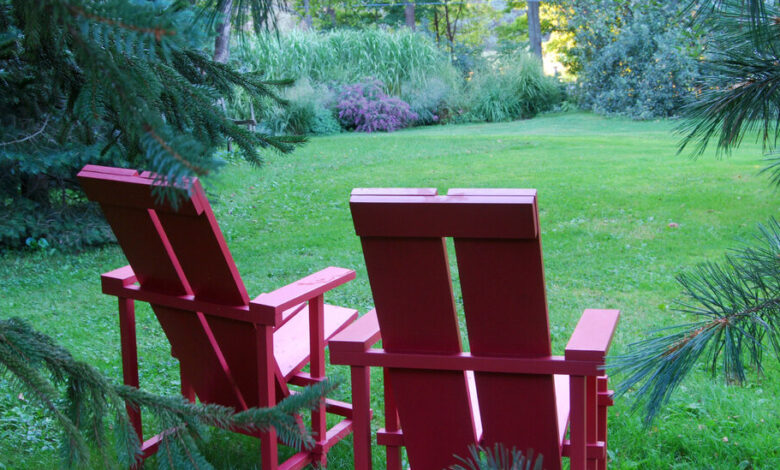Throw-in-the-Trowel Week (and How to Get Past It)

[ad_1]
Each year, right about now, I want to declare it Throw-in-the-Trowel-Week, as the aftermath of spring’s tender, joyous effusion goes beyond charmingly fuzzy to just plain frowzy and tattered.
The garden has a bad case of what a friend calls “the shaggies,” not to be confused with similar terms for a hairdo or a dance, or even a variant of the charming British slang for sex. It’s looking messy out there.
In the second half of June, I’m overcome by the inclination to close my eyes — to make it all disappear in “see no evil” fashion. To go back indoors and rewatch episodes of “Six Feet Under” while entertaining fantasies of plowing under the worst garden areas and erasing them.
I find myself wandering around, carrying the remains of a flat of potted perennials that have yet to find their forever homes. It’s a not-so-unconscious yearning: If only these creatures ordered months ago with who knows what in mind could prove the missing pieces of the puzzle before me, and complete the picture. If only they could fix everything.
But those few unplaced plants won’t do it; the scene has grown too unfocused. This is no time to look away, however strong the urge.
Interventions that happen now — in vegetable beds, to certain perennials and shrubs, against weeds — will reinvigorate the garden, to keep it looking good and being productive through frost.
Edge, Mulch, Water — and Weed
This is not the big spring cleanup, or the fall one. It’s more about targeted grooming and committing to giving the neediest areas regular, deep drinks in the hot weeks to come.
Water early in the morning, focusing extra attention on container plants and anything newly planted, which includes the entire vegetable garden. If you’re having problems keeping up with watering, it may be time to install a simple drip-irrigation system.
The same friend who came up with “the shaggies” offers this maxim when I voice my annual feeling of being overwhelmed: “Clean edges and fresh mulch can hide a multitude of sins.”
A thin top-dressing is all that is needed, assuming you mulched this spring. If the lines between lawn and bed are blurred or wobbly, use the step-on, half-moon edger in the worst spots to recut them cleanly. Yes, I know: there’s the weed-whacker. But its brute force can be a bit much when desired plants are close to the border line.
The quieter solution is my pair of 10-inch Wiss stainless-steel shop shears, which resemble sturdy, oversized scissors. They do the job fine — as does manually pulling up the ground ivy (Glechoma hederacea) and Prunella that want to overtake and spoil things. The shears are also good for clipping around steppingstones and other pavers; seeing paths free of encroachment from enthusiastic turf offers another welcome bit of visual relief.
This time of year, warm-season weeds are gaining ground fast. Asiatic dayflower (Commelina communis), spotted spurge (Euphorbia maculata), purslane (Portulaca oleracea) and hairy galinsoga (Galinsoga ciliata) are among the prolific demons that command attention, or else.
But the worst may be those that sow into the gravel of paths or the driveway. A Dutch hoe or Dutch scuffle hoe (like those from Clarington Forge or Sneeboer), or even a stirrup hoe — tools that cut just below the surface on both the push and pull motions — make this job faster and easier on the knees. Follow up by raking off the dislodged weeds.
This weed-removal policy has exemptions: Two natives are each allowed a modest territory. Clearweed (Pilea pumila) is a host plant for various butterfly caterpillars, and fans of jewelweed (Impatiens capensis) include hummingbirds, some moth caterpillars, bumblebees and honeybees. Know your weeds.
A Fourth of July Goal: Those Messy Lilacs
Looking at faded lilac flowers, one appreciates trees and shrubs that simply drop their spent spring blossoms, requiring a mere pass of the rake to tidy up — or those, like crab apples, whose flowers seem to evaporate.
Common lilacs (Syringa vulgaris) and the hyacinthiflora types, too, leave behind their big, dried-up trusses. Time is running out to deadhead them without interfering with the start of next year’s bud set. In my northern garden, I aim to finish this task by the Fourth of July.
Cut each faded flower cluster at its base, just above the two new angled shoots that will hold next year’s buds and blooms. With large shrubs, this is ladder work. Better, and far safer, would be to invest in a lightweight, tubular aluminum long-reach or telescoping pruner, like those made by ARS Corporation. Then tackle this and other light pruning from solid ground.
Cutbacks, Cutbacks, Cutbacks
Sometimes, the first step toward making things better is to make them look worse. That’s especially true with perennials in need of severe haircuts.
Common early bloomers like Euphorbia polychroma and some perennial geraniums just got theirs in my garden. Before long, the catmints (Nepeta) and lady’s mantle (Alchemilla mollis) will join the list. Cutting them back hard leaves gaps in beds as they’re reduced to stubble, but a flush of new growth will emerge in a few weeks.
By now, the foliage of spring-blooming bulbs will have done its job nourishing the underlying bulbs; it can go, too. Daffodil drifts in the lawn can be mowed and the debris raked off; simply remove the withered leaves of smaller clumps in beds.
Some deadheading isn’t motivated by aesthetics, but another form of self-defense: to keep the garden from being overrun by self-sowns. Even something as charming as columbine can overdo itself, so I deadhead a portion of the seed heads. The celandine poppy (Stylophorum diphyllum) is too prolific. I cut it down, then pinch off seed heads to share with friends or put in the trash, rather than ending up with garden beds (or a compost heap) covered in too much of a good thing.
There’s another strategic form of cutting back that doesn’t involve deadheading finished flowers. Some perennials like tall phlox (Phlox paniculata), sneezeweed (Helenium), various asters and Joe Pye weeds (Eutrochium) can be pinched by about half to prompt them to bloom slightly later, at maybe two-thirds of their normal height, and bushier. But hurry — this is another task to complete soon, or skip altogether.
Succession Sowings: The Fall Vegetable Garden
Other than plant-them-once crops like tomatoes, eggplants and peppers, many edibles are best sown more than once, for a continuing supply into fall (and even later, with the smart use of garden covers).
Succession sowings to the rescue: Basil seeded now will be in prime condition at peak tomato harvest, and for making pesto to freeze for winter use. Likewise, another round of dill should go in, for pickling season. Cilantro needs reseeding every couple of weeks, and what about a short row of scallions?
Where edible podded or shelling peas will soon peter out and be cut down, the space could be left open to sow fall peas in July. Or it could be used for something else — greens galore, on repeat: lettuce, arugula, mustard, chard, spinach, leaf broccoli (called spigariello), as well as more kale and collards. And now is the moment for radicchio.
In go more beets and turnips (for greens or roots, or both), carrots and radishes. Bush beans are on the list, too, and maybe even a bush zucchini or cucumber (a variety whose description says the growing time is about 50 days to maturity).
Hot, dry soil and weed pressure can be hard going for direct-sown seeds. Sowing them in flats and transplanting them later may prove easier with most everything except root crops, which generally don’t like transplanting.
When and how late can you sow? Count back from your first fall frost date and adjust a bit for the slower growth that will come with shortening days and generally cooler ones, too, as these late crops approach maturity. Add about two weeks to the estimated days to harvest listed on the packet. (You may want to consult fall vegetable-sowing calendars, with advice from around the country.)
Important: Leave room for the garlic, which will be planted around October — perhaps where the tomatoes are now.
Some Not-So-Magic Tricks
And then there is the tactic of deploying a little theater — adding drama to draw the eye. A pair of colorful chairs can do that, or a grouping of well-placed containers, especially large ones filled with a shrub from the garden center’s late-spring sale, or maybe a Japanese maple.
Bold tropicals from the houseplant department could be used in the same way, and will provide year-round enjoyment.
Want more drama? Try adding clematis vines where they can scramble up and over shrubs that have already done their thing — a sort of second showing in shaggy seasons of years to come, courtesy of the flowering climber.
One year, in mid-June, I had a big gap where a shrub had died in a prominent bed, and nothing to fill it as spring slipped away. A packet of leftover winter squash seeds provided the answer. Within weeks, the hole had been erased by bold leaves on fast-expanding vines.
That would have been enough to satisfy me. But frost came late that year, and there were even a few Butternut squash for the soup pot.
Margaret Roach is creator of the website and podcast A Way to Garden, and a book of the same name.
For weekly email updates on residential real estate news, sign up here. Follow us on Twitter: @nytrealestate.
[ad_2]
Source link






